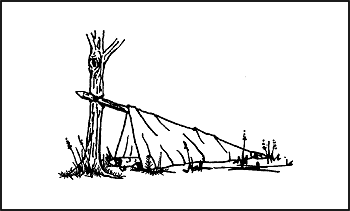Chapter 5
Shelters
TYPES OF SHELTERS
ONE-MAN SHELTER
5-27. A one-man shelter (Figure 5-7) you can easily make using a parachute requires a tree and three poles. One pole should be about 4.5 meters (15 feet) long and the other two about 3 meters (10 feet) long.
Figure 5-7. One-Man Shelter
5-28. To make this shelter, you should—
Secure the 4.5-meter (15-foot) pole to the tree at about waist height.
Lay the two 3-meter (10-foot) poles on the ground on either side of and in the same direction as the 4.5-meter (15-foot) pole.
Lay the folded canopy over the 4.5-meter (15-foot) pole so that about the same amount of material hangs on both sides.
Tuck the excess material under the 3-meter (10-foot) poles and spread it on the ground inside to serve as a floor.
Stake down or put a spreader between the two 3-meter (10-foot) poles at the shelter's entrance so they will not slide inward.
Use any excess material to cover the entrance.
5-29. The parachute cloth makes this shelter wind-resistant, and the shelter is small enough that it is easily warmed. A candle, used carefully, can keep the inside temperature comfortable. However, this shelter is unsatisfactory when snow is falling, as even a light snowfall will cave it in.
Survival index
All text and images from the U.S. Army Field Manual 3-05.70: Survival.
Appearance of the materials from the U.S. Army Field Manual here does not constitute or represent endorsement by probablyhelpful.com.
ProbablyHelpful.com is not responsible for inaccurate or outdated information provided by the U.S. Army Field Manual 3-05.70.

